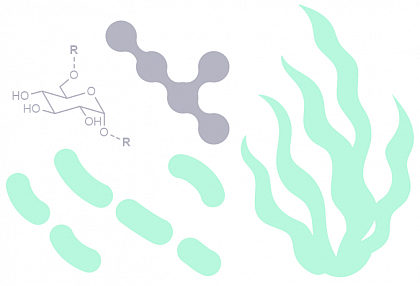Research

The research in the Wefers group focuses on various oligo- and polysaccharides from bacteria or algae as well as glycoproteins of various origins. These biomolecules can be used in food in isolated form to improve the texture or nutritional properties. In the case of bacterial exopolysaccharides, formation in food is also possible, for example during fermentation.
The working group deals with several topics relating to various carbohydrates, which often have an enormously complex structure.
Structural analysis and characterization
The molecular structure of many carbohydrates or carbohydrate-containing biomolecules is often not yet (fully) described or understood, however, the behaviour in model systems, in food and in the digestive tract is crucially dependent on the structure. Detailed structural characterisation is therefore a central aspect of our research.
In terms of methodology, we use established methods such as methylation analysis (analysis of partially methylated alditol acetates using GC-MS/FID) for structural analysis. One- and two-dimensional NMR spectroscopy is also frequently used, while the absolute molecular weight is determined using HPSEC-RI/MALLS. Together with the monosaccharide composition (determined by HPAEC-PAD after acid hydrolysis), the analytical methods mentioned usually provide the most important information on the molecular structure of oligo- and polysaccharides.
In some cases, however, these approaches are not sufficient, e.g. for polysaccharides that consist of only one type of monosaccharide (homopolysaccharides) or when many different structural units occur in varying and sometimes very small portions. To obtain detailed structural information, we therefore also rely on the characterization of enzymatically or chemically released oligosaccharides. These compounds are isolated from the hydrolysates using GPC and semi-preparative HPLC and then characterized using NMR spectroscopy and mass spectrometry. Finally, the structure of the fragments obtained provides information on the structural elements present in the polymers.
Due to the aforementioned limitations of the conventionally used analytical methods, we are continuously working on developing new approaches for analyzing polymeric carbohydrates. The focus here is on approaches based on chromatographic analysis of the enzymatically released oligomers described above. Suitable methods here are HPAEC-PAD or HPLC with ELSD and/or MS detection. Information on the portions of the respective structural elements in the polymers can then be derived from the oligosaccharide profiles. This approach has already been used successfully for various bacterial glucans, for example.
Synthesis, cleavage & modification
In addition to the (structural) analysis of oligo- and polysaccharides, our research work also focuses on the enzymatic synthesis and modification of carbohydrates. For example, various bacteria can enzymatically convert low-molecular carbohydrates such as sucrose into oligo- and polymeric glucans or fructans. To produce the respective carbohydrates, we use microorganisms as well as purified recombinant enzymes. We obtain the latter by cloning of the responsible genes and heterologous expression in E. coli. By selecting different enzymes or incubation conditions, tailor-made polysaccharides with optimal properties for different applications can be obtained.
We also use recombinant, carbohydrate-active enzymes for the modification of polysaccharides. In contrast to chemical processes, this approach offers the possibility of selectivel cleaving the complex polymers as well as removing or adding certain substituents or side chains. In some cases, however, we also use chemical approaches for polysaccharide modification, e.g. for de-esterification.
Structure-functionality relationships
By using the modified or biotechnologically produced, well-characterized carbohydrates, we finally work on the determination of structure-functionality relationships. Among other things, we are investigating the stability and functionality of various carbohydrates in model systems and different foods. The relationship between molecular structure and nutritional properties is also of interest. To investigate these complex issues, we work together with partners from various other groups.
Occurrence and formation in food
Another focus is the analysis of various oligo- and polymeric carbohydrates in foods. On the one hand, we are investigating the polysaccharides present in fermented foods such as water kefir, kombucha, or sourdough. Methods adapted to the respective matrices are developed for this purpose. On the other hand, we are also looking at how the formation of certain polysaccharides can be specifically influenced and increased during fermentation. This approach offers, for example, the possibility of specifically increasing the dietary fiber content or the content of prebiotic carbohydrates in foods.
Ongoing & completed third-party funded projects
The publications listed on the “Publications” page provide an insight into our research work, while the abstracts of our completed and current externally funded projects can also be viewed here (mostly German).
Current projects:
https://gepris.dfg.de/gepris/projekt/460131094
https://www.fei-bonn.de/gefoerderte-projekte/projektdatenbank/aif-21935-bg.projekt
https://www.fei-bonn.de/gefoerderte-projekte/projektdatenbank/01if23030n.projekt
https://www.fei-bonn.de/gefoerderte-projekte/projektdatenbank/01if23048n.projekt
https://www.fei-bonn.de/gefoerderte-projekte/projektdatenbank/01if23336n.projekt
https://www.dip-sachsen-anhalt.de/projekt/dip-lefos/
Completed projects
Ice recrystallization inhibitory activity of carrageenans (DFG)
https://gepris.dfg.de/gepris/projekt/413076269
Starch modification in sourdough (FEI)
21647 BR - FEI Kurzbericht.pdf
(418.3 KB) vom 12.07.2024




